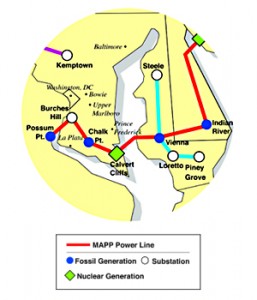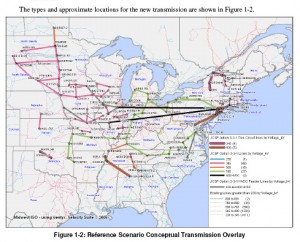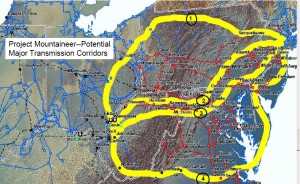Offshore transmission, NOT transmission from Midwest
December 6th, 2009
By standing up for offshore transmission for wind, Delaware’s Gov. Jack Markell stands up to Midwest coal!
The Mid-Atlantic states have been standing up and opposing transmission from the Midwest. They’ve gone on record in a number of venues, and in their opposition are citing Midwest transmission promoters’ disregard for eastern renewable efforts, that xmsn may well not be an economical way to get power to the east, and that THEY KNOW THAT MIDWEST TRANSMISSION PLANS INHERENTLY ARE ABOUT COAL. The plan they’re referring to is a massive transmission buildout known as JCSP, and it also applies to the big PJM buildout that includes the PA-NJ Susquehanna-Roseland transmission line that was the subject of a hearing last month.
Here’s JCSP (Joint Coordinated System Plan) note their site now talks about wind — but look where the transmission starts, DUH! The coal fields of the Dakotas:
Gotta give them, Delaware, Maryland and Virginia, a lot of credit for recognizing and stating what Midwest states have been unwilling to admit.
That said, here’s what Mid-Atlantic states are doing — they’re banding together to propose offshore transmission. If it’s underwater offshore transmission, that’s an idea that’s hard not to like. But I’ll bet it throws PJM for a loop, what with all their “backbone” transmission schemes, a la Project Mountaineer, that are in the works:
The FERC birth of Project Mountaineer:
And you can see that those lines in play now, PJM’s “backbone” transmission projects like Susquehanna-Roseland (NE part of Project Mountaineer Line 1) and MAPP (NE part of Project Mountaineer Line 4) are part of the plan… the big transmission plan that does not work for the east coast.
Here’s the Memorandum of Understanding between Delaware, Maryland and Virginia:
And recently, Gov. Jack Markell addressed these issues before American Wind Energy Association’s offshore windfest — but given the PJM big-transmission-projects-from-hell are referred to as “backbone” projects, I wish they’d find another term:
Delaware energy: ‘Backbone’ power line pushed for wind farms
By AARON NATHANS
The News JournalGov. Jack Markell broached the subject this week in his address to the American Wind Energy Association’s offshore wind workshop, the industry event of the year on this side of the Atlantic. Markell signed onto letters the governors sent to members of Congress this summer, and the Federal Energy Regulatory Commission last month.
“Let’s have the conversation,” O’Mara said. “It’s extremely worthy of further study.”
“It obviously won’t happen in the absence of federal leadership,” he said.
Fishermen’s Energy President Daniel Cohen said it’s a good idea, but “it’s another moving part.”
The benefits of building lines transmitting wind power from the Midwest are less certain, he said.
“It will be difficult to get progress in this area until there are clear national goals,” he said.
Note that “cost allocation” is raised. Since the 7th Circuit decision tossing out FERC approval of PJM’s transmission cost allocation dream/nightmare, all transmission projects 500kV and over based on that cost allocation scheme are in limbo.
So as noted, who pays, and submarine transmission is EXPENSIVE, is THE big issue now. It’s the big issue for land transmission, it’s the big issue for offshore transmission, and, given the uncertainty since the 7th Circuit decision, maybe some of the sturm and drang could be circumvented if it’s designed at 345kV or below, and uses the “benefactor pays” theory. We shall see…
Closing coal plants and lack of need in PJM
December 4th, 2009
We all know “need” for electricity is down, down, down:
Take a few minutes and scan that report — it’s telling it like it is. Prices down 40+ % and demand down at least 4+% this year so far (that’s what they’ll admit to, and I figure it’s a lot worse than that!).
Decreased demand was a reason for cutting out the Indian River – Salem part of the MAPP line…
HOT OFF THE PRESS, decreased demand is the reason coal plants are being shut down in Pennsylvania, FOUR coal plants in Pennsylvania:
Exelon to close 4 Penn. generating units by 2011
Alan says that the Eddystone ones are a couple of the first supercritical coal plants around, they’ve been running for ages. But that they’d close down the coal and keep oil-burning units? What gives? Peaking power? Or??? Doesn’t make sense to me. It doesn’t get much dirtier than burning fuel oil. Those have to go too…
Baltimore: Rally on Tuesday — say NO to transmission for coal!
November 29th, 2009
It’s so good to be home … for a second or so, that is, before the CapX 2020 Brookings public and evidentiary hearings start. For more on that, go to NoCapX 2020!
PJM’s Mid-Atlantic Power Pathway is in the news again… or is it PEPCO… or is it Delmarva Power… yes, another stupid transmission idea comin’ down the pike… it’s time to say NO! to transmission for coal!
Join the “No New Coal” brigade at the rally:
Baltimore’s Preston Gardens Park
Don’t get confused by this map of MAPP — they’re now admitting that the part from Indian River to Salem “isn’t needed” and it’s only a matter of time before they figure out that a 500kV line to nowhere isn’t needed either.

From The Diamondback, the University of Maryland’s paper – YES! maybe there’s hope, maybe they’ll do a better job than we have:
MAPP and PATH: Time to draw the line
Are people starting to get it? Here’s another from the Diamondback:
Guest column: Toppling King Coal
Krishna Amin is a junior biochemistry major. She can be reached at krish121 at umd dot edu.
How far down does electrical demand have to go…
November 23rd, 2009
… before they back off on these stupid infrastructure projects?
We finished up the Susquehanna-Roseland hearing today, Stop the Lines has weighed in. Time to say goodbye to beautiful downtown Newark.
For me, the best parts today were:
1) Finally… FINALLY… getting some credible testimony about the capacity of that line. Let’s see, they’re planning to double circuit it with 500kV, getting rid of the 230kV, but when… and they’ve designed the substations for 500kV expansion. So DUH! Here’s the poop:
140C for a 1590 ACSR Falcon @ 500kV – PJM summer normal rating conditions = 1838 amps
4 conductors = 7,352 amps
3 conductors – 5,514 amps or 4,595 MVA
2) Clear statement on the record about the Merchant Transmission’s Firm Transmission Withdrawal Rights:
Neptune 685MW
ECP 330 MW (VFT?)
HTP 670MW
TOTAL: 1,670 MW already heading across the river
And getting those numbers in was not easy, PSEG did NOT want this in the record. It’s confirmed in the PJM Tariff, STL-12, p. 3 of the exhibit, p. 2 of SRTT-114 (BPU Staff IR). But there’s something else disturbing going on here. We were supposed to question Essam Khadr about “Leakage,” which is “New Jerseyian” for the increased coal generation that will be imported if CO2 costs are assessed:
That will take some time to wrap my head around.
Here’s PJM’s 3Q bad news, well… good news to me! Because it continues to go down:
And if that’s not enough, here’s the Wall Street Journal:
Weak Power Demand Dims Outlook
Susquehanna-Roseland hearing
November 20th, 2009
It’s warm here in New Jersey, unseasonably. We’re slogging through the hearing.
The good news is that we’ve gotten pretty much everything in the record that we need, including, well not quite, got the 2Q State of Market, and last night I found that the 3Q was released November 13:
(great, can’t upload here, grrrrrrrrrr)
Page 9 will tell you all about decreased peak demand:
2005 133,761
2006 144,544
2007 139,428
2008 129,481
2009 126,805
Down 2,676 MW this year, down 9947 from 2007 to 2008. Down every year since 2006!
Here’s a report of yesterday’s festivities:
State told power plan pros, cons
By SETH AUGENSTEIN
saugenstein@njherald.comFour attorneys cross-examined the experts, with few breaks.
“I would appreciate it if you would just ask a question,” he said.
The opposition attorneys said they were getting the job done.
“We got on the record what we wanted on the record,” Tamasik said.





